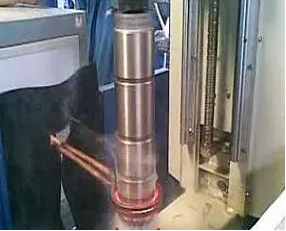- 20
- Jun
Operation specification requirements for high frequency quenching equipment
Operation specification requirements for lisebelisoa tse phahameng tsa ho tima
1. Basebelisi ba lisebelisoa tse timang maqhubu a phahameng ba tlameha ho feta tlhahlobo le ho fumana setifikeiti sa ts’ebetso pele ba lumelloa ho sebetsa. Mokhanni o lokela ho tloaelana le ts’ebetso le sebopeho sa lisebelisoa, ‘me a ikamahanye le ts’ireletso le sistimi ea ts’ebetso;
2. There must be more than two people to operate the high-frequency quenching equipment, and the person in charge of the operation must be designated;
3. When operating the high-frequency quenching equipment, check whether the protective shield is in good condition, and idle people are not allowed to enter during work to avoid danger;
4. Before working, check whether the contact of each part of the equipment is reliable, whether the quenching machine tool is running well, and whether the mechanical or hydraulic transmission is normal;
5. When preparing to turn on the water pump during work, check whether the cooling water pipes are smooth and whether the water pressure is between 1.2kg-2kg. Be careful not to touch the cooling water of the equipment with your hands;
6. The power transmission preheating is performed at the first stage, the filament is preheated for 30min-45min, and then the second stage is performed, and the filament is preheated for 15min. Close and continue to adjust the phase shifter to high voltage. After adding high frequency, hands are not allowed to touch the busbars and inductors;
7. Install the sensor, turn on the cooling water, and drain the workpiece before the sensor can be energized and heated, and no-load power transmission is strictly prohibited. When replacing the workpiece, the high frequency must be stopped. If the high frequency cannot be stopped, the high voltage should be cut off immediately or the emergency switch should be connected;
8. During the operation of the high-frequency quenching equipment, it should be noted that the positive flow and the powder flow are not allowed to exceed the specified value;
9. When working, all the doors should be closed. After the high voltage is closed, do not move to the back of the machine at will, and it is strictly forbidden to open the door;
10. Haeba liketsahalo tse sa tloaelehang li fumanoa ts’ebetsong ea lisebelisoa tsa ho tima li-high-frequency quenching, motlakase o phahameng o lokela ho khaoloa pele, ebe liphoso li lokela ho hlahlojoa le ho felisoa.
11. Kamore e lokela ho ba le lisebelisoa tsa moea ho tlosa khase ea flue le khase e litšila e hlahisoang nakong ea ho tima le ho sireletsa tikoloho. Mocheso oa ka tlung o lokela ho laoloa ho 15-35 ° C.
12. Ka mor’a ho sebetsa, qala ka ho khaola motlakase oa anode, ebe u khaola matla a matla a filament, ‘me u tsoele pele ho fana ka metsi bakeng sa 15min-25min, e le hore tube ea elektronike e pholile ka ho feletseng, ebe e hloekisa le ho hlahloba thepa, e boloke e hloekile ebile e hloekile. omella ho thibela likarolo tsa motlakase ho tsoa le ho robeha. Ha u bula monyako oa ho hloekisa, tlosa anode, grid, capacitor, joalo-joalo pele.

